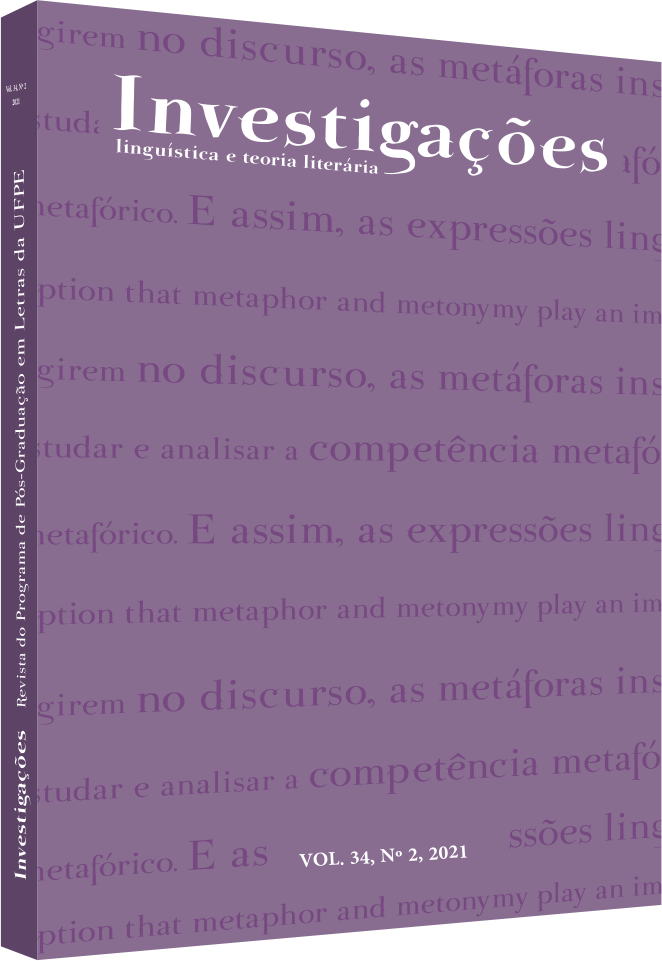Saussure frente a seus contemporâneos: uma análise das questões relativas ao sentido nos primeiros capítulos do manuscrito De l’Essence Double du Langage
DOI:
https://doi.org/10.51359/2175-294x.2021.251212Keywords:
meaning, saussurean studies, 19th-century linguistics, De l’Essence Double du Langage.Abstract
This article investigates the place given to meaning in saussurian theoretical elaboration at the end of the nineteenth century. Thus, the first chapters of the manuscript De l'Essence Double du Langage(SAUSSURE, 1891) are analyzed. Moreover, the genebrine’s theoretical elaboration is compared to those of his contemporaries (WHITNEY, 2010; PAUL, 1966; BRÉAL, 1992). Finally, one infers that Saussure seemed to elaborate a theoretical construct placing meaning as the centre of linguistic analysis. Besides, the linguist departs from the thought developed by his contemporaries, but breaks with such tradition, thus thinking of meaning synchronically and not giving relevant place to temporal change in his theoretical elaboration.References
BAGNO, M. Excurso crítico para uma leitura incontornável. In: SAUSSURE, F. de. Curso de Linguística Geral. São Paulo: Parábola, 2021.
BOUQUET, S. Saussure’s unfinished semantics. In: SANDERS, C. (org.) The Cambridge Companion to Saussure. Cambridge: CUP, 2004.
BRÉAL, M. (1897) Ensaio de semântica: ciência das significações. São Paulo: Pontes Editores, 1992.
CAMARA JR. J. M (1975). História da Linguística. Petrópolis: Vozes, 2021.
CHIDICHIMO, A ; GAMBARARA, D. 2008. Trois chapitres de 'L'essence double du langage'. In : Cahiers Ferdinand de Saussure : revue suisse de linguistique générale, Genève: Librairie Droz, n.61, 2008.
DE LEMOS et alli. Le saussurisme en Amérique Latine au XXe siècle. In : Cahiers Ferdinand de Saussure: revue de linguistique générale. Genève: Librairie Droz, n. 56, 2004.
DEPECKER, L. Compreender Saussure a partir dos manuscritos. Petrópolis: Vozes, 2012.
FLORES, V. Problemas Gerais de Linguística. Petrópolis: Vozes, 2019.
GRÉSILLON, A. Elementos de crítica genética: ler os manuscritos modernos. Porto Alegre: Editora da UFRGS, 2007.
GUIMARÃES, E. Os limites do sentido: um estudo histórico e enunciativo da linguagem. Campinas: Pontes, 2005.
MILNER, J-C. (1989) Introdução a uma ciência da linguagem. Petrópolis: Vozes, 2021.
NORMAND, C. Saussure. Trad. Marcelo Diniz e Ana de Alencar. São Paulo: Estação Liberdade, 2009.
PAUL, H. (1886) Princípios fundamentais da história da língua. Lisboa: Fundação Calouste Gulberkian, 1966.
SAUSSURE, F. de (1891). Essência Dupla da Linguagem. Manuscrito.
SAUSSURE, F. de (1916). Curso de Linguística Geral. São Paulo: Cultrix, 1970.
SAUSSURE, F. de. (2002). Escritos de Linguística Geral. Edição de ENGLER, R. e BOUQUET, S. São Paulo: Cultrix, 2004.
SILVEIRA, E. Saussure à brasileira: estatuto epistemológico do Curso de linguística geral nos manuais publicados entre 1930 e 1980. In: FARACO, C. A. (org.). O efeito Saussure: cem anos do Curso de linguística geral. São Paulo: Parábola, 2016.
SILVEIRA, E. As marcas do movimento de Saussure na fundação da linguística. São Paulo: Mercado de Letras, 2007.
SILVEIRA, E. Ensaio sobre a variedade das rasuras em alguns manuscritos de Saussure. In: D.E.L.T.A., n.º 34, v. 3, pp. 835-859, 2018.
SOFIA, E. Quelques problèmes philologiques poses par l’œuvre de Ferdinand de Saussure. In: Langages. v.185, pp.35-50. Paris: Armand Colin, 2012.
WHITNEY, W. D. (1875) A vida da linguagem. Petrópolis: Vozes, 2010.
Downloads
Published
How to Cite
Issue
Section
License
Copyright (c) 2021 Maurício Marques Sortica

This work is licensed under a Creative Commons Attribution 4.0 International License.
Authors who publish with Revista Investigações agree to the following terms:
Authors retain copyright and grant the journal right of first publication with the work simultaneously licensed under the Creative Commons Attribution 4.0 International (CC BY 4.0) license that allows others to share the work with an acknowledgement of the work's authorship and initial publication in this journal.
Authors are able to enter into separate, additional contractual arrangements for the non-exclusive distribution of the journal's published version of the work (e.g., post it to an institutional repository or publish it in a book), with an acknowledgement of its initial publication in this journal.
You are free to:
Share — copy and redistribute the material in any medium or format for any purpose, even commercially.
Adapt — remix, transform, and build upon the material for any purpose, even commercially.
The licensor cannot revoke these freedoms as long as you follow the license terms.
Under the following terms:
Attribution — You must give appropriate credit , provide a link to the license, and indicate if changes were made . You may do so in any reasonable manner, but not in any way that suggests the licensor endorses you or your use.
No additional restrictions — You may not apply legal terms or technological measures that legally restrict others from doing anything the license permits.

